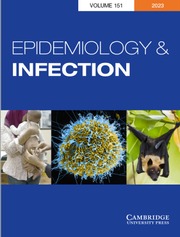In the article by O. Bucher, A. Fazil, A. Rajic, A. Farrar, R. Willis and S. A. McEwen [Reference Bucher, Fazil, Rajić, Farrar, Wills and McEwen1] presented in Epidemiology and Infection, several values given in tables 1 and 2 were incorrect. Tables 1 and 2 are republished here with the correct values.
Table 1. Selected interventions (based on systematic review-meta-analysis) and their respective inputs for the quantitative exposure assessment model

a Intervention application point.
b For each intervention type up to three datasets were selected to represent intervention profile. The selection was based on a combination of arbitrary, biologic and contextual criteria.
c Studies (papers) confirmed relevant during the SR-MA process.
d Number of relevant studies (trials) for each intervention type or product that were included in random-effect MA.
e ChT–challenge trial, CT – controlled trial.
f Random allocation of intervention/concealment of treatment.
Randomized and/or non-randomized clinical or field trials and/or challenge trials.
g RD – Risk difference, MD – Mean difference.
h Statistical significance of heterogeneity (⩾25%) and publication bias (⩽0·1) as measured through Egger's regression asymmetry test.
i Calculated from MA.
j Selected for inclusion in the quantitative exposure assessment.
k Not applicable.
l PMBH – polyhexamethylenebiguanide hydrochloride.
m Calculated from individual studies.
Table 2. Description of the variables used to model Salmonella status in broiler chickens at the grow-out farm

a Beta (α, β).
b Pert (minimum, most likely, maximum).
c Uniform (minimum, maximum).
d Cumulative (minimum, maximum, range of values, cumulative probability of each value in range).
e Values chosen based on authors' discretion.




